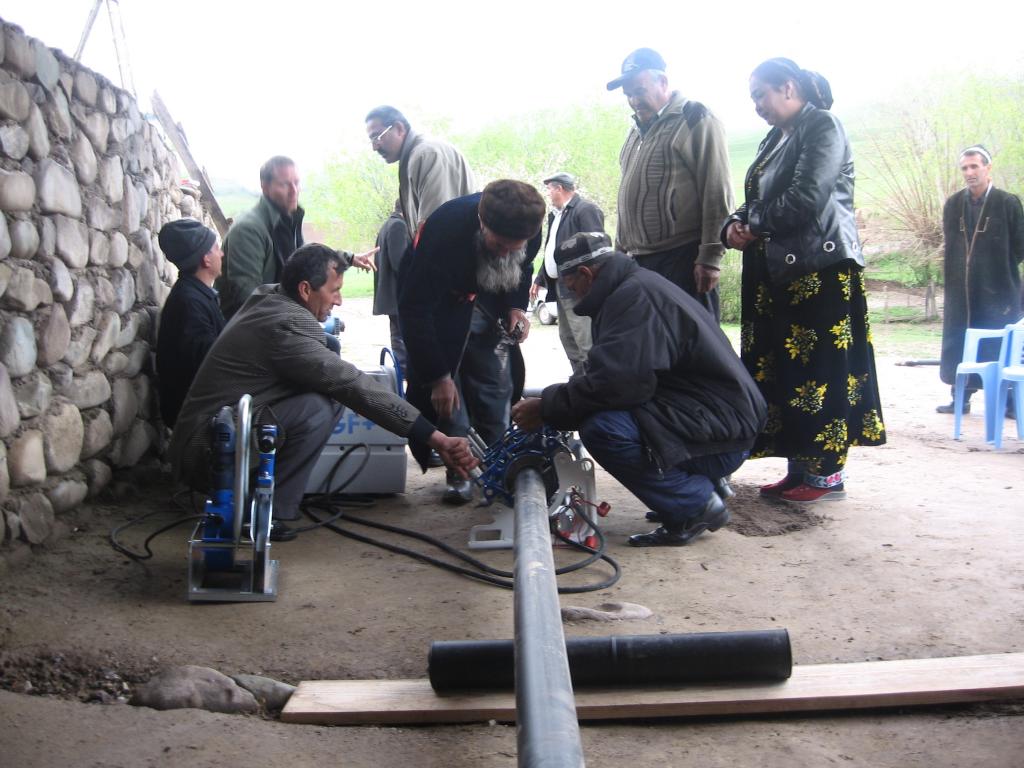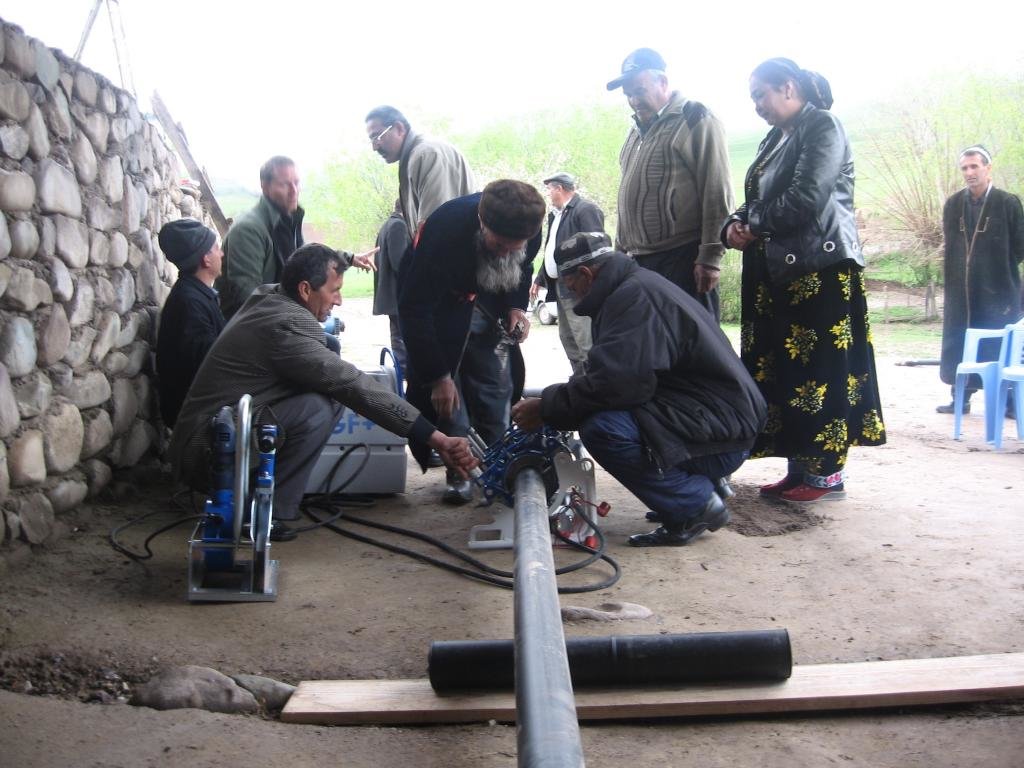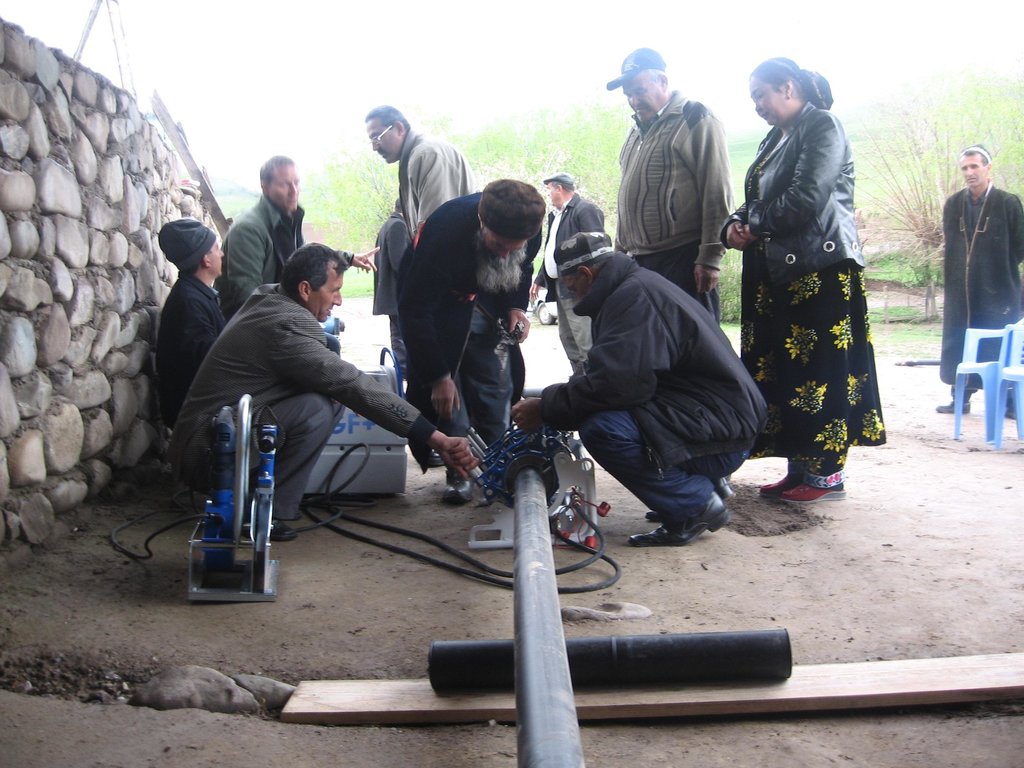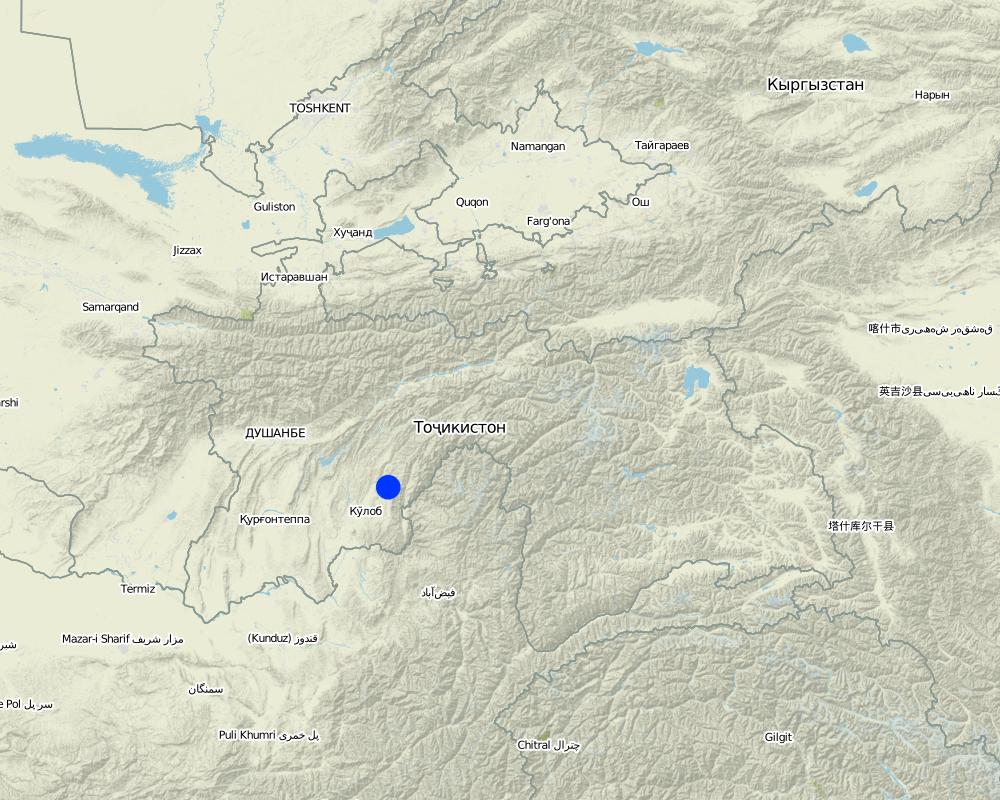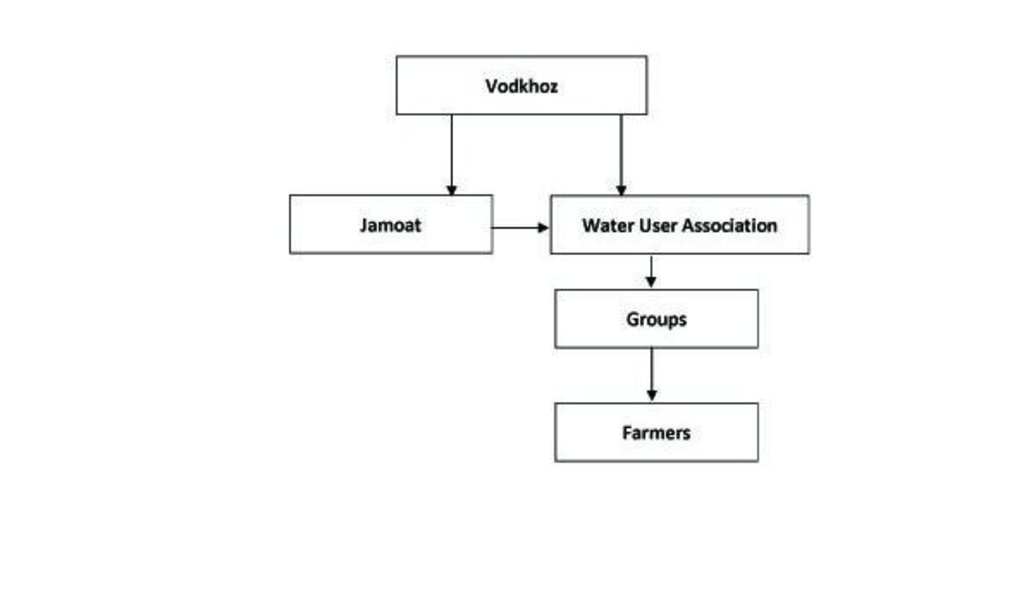Water User Association [塔吉克斯坦]
- 创建:
- 更新:
- 编制者: Sa'dy Odinashoev
- 编辑者: –
- 审查者: David Streiff
Ассотсиатсияи Истифодабарандагони Об
approaches_2458 - 塔吉克斯坦
查看章节
全部展开 全部收起1. 一般信息
1.2 参与方法评估和文件编制的资源人员和机构的联系方式
土地使用者:
Kassirov Gayur
WUA
塔吉克斯坦
有助于对方法进行记录/评估的机构名称(如相关)
CARITAS (Switzerland) - 瑞士1.3 关于使用通过WOCAT记录的数据的条件
编制者和关键资源人员接受有关使用通过WOCAT记录数据的条件。:
是
2. SLM方法的描述
2.1 该方法的简要说明
Management and control of the water distribution, maintenance of the infrastructure and water conflict resolution by the locally organized association
2.2 该方法的详细说明
该方法的详细说明:
Aims / objectives: Under the National land reform of the Republic of Tajikistan, land resources, which used to belong to kolkhozes and sovkhozes, were distributed to individual households. Such division had two consequences, on the one hand, villagers were given opportunity to develop the land privately as an income-generating source, and on the other hand, it intensified the conflicts over water. The government was not capable to solve the disputes over water and manage the water resources sustainably because of lack of finances and lack of staff. A water users association was created with the aim to replace the former Soviet water management system and to ensure systematic and timely distribution of irrigation water and maintenance, as well as to improve the infrastructure.
Methods: This approach involves thee different actors: association members (water users), the association and the government. The association members have to stick to certain conditions in order to join, namely, they have to pay annual membership fees and water taxes fixed by the government. Government, on its turn, ensures uninterrupted supply of the agreed amount of water and the association is responsible for the control and equal water distribution and all related technical works.
Stages of implementation: Steps involved in creation of the water users association.
1) Local leaders met with representatives of Vodhoz (local state agency, regulating water resources) to discuss creation of an independent association with a full mandate over irrigation water management; 2) Leaders organized a general meeting with people of 5 villages in Muminabad district to inform them about the role and importance of establishing a locally based association and discuss conditions for its membership; 3) Charter of the association was developed, 5 leaders representing villages were elected and the amount of a membership fee was agreed upon; 4) The association was registered as a legal entity; 5) Needed amount of water per growing season was calculated and agreed upon; 5) The Leaders (of association?) and Vodvoz concluded an agreement, according to which, Vodhoz is obliged to provide the required amount of water and the association leaders agree to collect the determined fees for water from the water users and to deliver it on time to Vodvoz.
Role of stakeholders: The role of the three main stakeholders (Vodhoz, association and water users) is to follow the rules of the association. There is a strong element of trust among the association and its members.
2.3 该方法的照片
2.5 采用该方法的国家/地区/地点
国家:
塔吉克斯坦
区域/州/省:
Khatlon
有关地点的进一步说明:
Muminabad
注释:
270 ha
Map
×2.6 该方法的开始和终止日期
注明开始年份:
2010
2.7 方法的类型
- 最近的本地倡议/创新
2.8 该方法的主要目的/目标
The Approach focused mainly on SLM with other activities (regulation of water distribution, water conservation, conflict resolution)
To establish a responsible body, recognized by the government and accepted by the local people, to manage water related issues and to maintain as well as to improve conditions of the infrastructure in the local level.
The SLM Approach addressed the following problems: The approach is addressing the problem connected with the use of the water resource. Incapability of the government to manage waters on the village level resulted in conflicts over water use, misusage of water and abundance of the infrastructure. This condition had a direct effect to productivity and to food security as a consequence.
2.9 推动或妨碍实施本办法所适用的技术的条件
财务资源和服务的可用性/可得性
- 阻碍
No funds available to maintain the infrastructure
Treatment through the SLM Approach: Annual membership fees
机构设置
- 阻碍
No strong and effective mechanism to regulate irrigation water resources at the local level.
Treatment through the SLM Approach: Establishment of the water users association at the local level and respresented by local people.
法律框架(土地使用权、土地和水使用权)
- 阻碍
Unclear situation with regard to water use rights and obligations.
Treatment through the SLM Approach: The condition that association was represented by the local leaders enlarged the trust among the population. During the general meetings local leaders of the association explained for what villages are paying and where money would be invested.
3. 相关利益相关者的参与和角色
3.1 该方法涉及的利益相关者及其职责
- 当地土地使用者/当地社区
Association leaders
- SLM专家/农业顾问
- 国家政府(规划者、决策者)
Water Agency/VODHOZ
如果涉及多个利益相关者,请注明领导机构:
Association leaders
3.2 当地土地使用者/当地社区参与该方法的不同阶段
| 当地土地使用者/当地社区的参与 | 指定参与人员并描述活动 | |
|---|---|---|
| 启动/动机 | 互动 | It was members of the local community, who thought of the idea and they approached the local water agency. |
| 计划 | 互动 | Local leaders organized the meeting where all interested villagers participated. |
| 实施 | 外部支持 | Implementation was entirely through the local community. |
| 监测/评估 | 无 | |
| Research | 无 |
3.3 流程图(如可用)
具体说明:
Organizational chart showing the establishment set up of the Water User Association
作者:
Sady Odinashoev
3.4 有关SLM技术选择的决策
具体说明谁有权决定选择要实施的技术:
- 仅限土地使用者(自主)
解释:
Decisions on the method of implementing the SLM Technology were made by by land users* alone (self-initiative / bottom-up)
4. 技术支持、能力建设和知识管理
4.1 能力建设/培训
是否为土地使用者/其他利益相关者提供培训?:
是
明确受训人员:
- 土地使用者
- 现场工作人员/顾问
培训形式:
- 在职
- 公开会议
- 课程
4.2 咨询服务
土地使用者有权使用咨询服务吗?:
否
4.3 机构强化(组织发展)
是否通过这种方法建立或加强了机构?:
- 是,非常
具体说明机构的强化或建立程度:
- 本地
具体说明支持类型:
- 财务
- 能力建设/培训
- 设备
4.4 监测和评估
监测和评估是该方法的一部分吗?:
是
注释:
technical aspects were regular monitored by project staff, government, land users through observations; indicators: None
economic / production aspects were regular monitored by project staff, government, land users through observations; indicators: None
area treated aspects were regular monitored by project staff, government, land users through observations; indicators: None
area treated aspects were regular monitored by project staff, government, land users through measurements; indicators: None
management of Approach aspects were regular monitored by project staff, government, land users through observations; indicators: None
management of Approach aspects were None monitored by project staff, government, land users through measurements; indicators: None
There were several changes in the Approach as a result of monitoring and evaluation: None
4.5 研究
研究是该方法的一部分吗?
否
5. 融资和外部物质支持
5.1 该方法中SLM组成部分的年度预算
如果不知道准确的年度预算,请给出一个范围:
- 10,000-100,000
注释(例如主要的资助来源/主要捐助者):
Approach costs were met by the following donors: international: 80.0%; local government (district, county, municipality, village etc): 10.0%; local community / land user(s): 10.0%
5.2 为土地使用者提供财政/物质支援
土地使用者是否获得实施该技术的财政/物质支持?:
否
5.3 对特定投入的补贴(包括劳动力)
- 设备
| 具体说明哪些投入得到了补贴 | 程度如何 | 对补贴做出具体说明 |
|---|---|---|
| 工具 | 充分融资 | |
- 建筑
| 具体说明哪些投入得到了补贴 | 程度如何 | 对补贴做出具体说明 |
|---|---|---|
| 石料 | 充分融资 | |
| 木材 | 充分融资 | |
- 基建
| 具体说明哪些投入得到了补贴 | 程度如何 | 对补贴做出具体说明 |
|---|---|---|
| 道路 | 充分融资 | |
| 学校 | 充分融资 | |
如果土地使用者的劳动力是一项重要的投入,那么是不是:
- 以现金支付
5.4 信用
是否根据SLM活动的方法给予信用值?:
否
6. 影响分析和结论性陈述
6.1 方法的影响
该方法是否帮助土地使用者实施和维护SLM技术?:
- 否
- 是,很少
- 是,中等
- 是,支持力度很大
Increase of yield. Farmers receive more yield from the small plots.
该方法是否有助于社会和经济弱势群体?:
- 否
- 是,很少
- 是,中等
- 是,支持力度很大
Did other land users / projects adopt the Approach?
- 否
- 是,很少
- 是,中等
- 是,支持力度很大
Did the Approach lead to improved livelihoods / human well-being?
- 否
- 是,很少
- 是,中等
- 是,支持力度很大
Since the certain mechanism of water management was developed, water disputes significantly reduced and productivity increased
Did the Approach help to alleviate poverty?
- 否
- 是,很少
- 是,中等
- 是,支持力度很大
6.2 土地使用者实施SLM的主要动机
- 增加生产
to improve crop production
- 增加利润(能力),提高成本效益比
to improve yield
- 减少工作量
- 环境意识
- well-being and livelihoods improvement
improvement of villagers' well-being, whose main income comes from the agriculture
6.3 方法活动的可持续性
土地使用者能否维持通过该方法实施的措施(无外部支持的情况下)?:
- 是
6.4 该方法的长处/优点
| 土地使用者眼中的长处/优势/机会 |
|---|
| Water management through such associations is of states' interest as well, and therefore state supports minilar initiatives. |
| Conflict resolution: Association leaders act as a conflict resolving body and due to their respectful position in the community, they are able to avoid serious conflicts. |
| Transparency: Association is initiated and regulated by the local leaders, therefore there is much more trust on them among water users. |
6.5 该方法的弱点/缺点以及克服它们的方法
| 土地使用者认为的弱点/缺点/风险 | 如何克服它们? |
|---|---|
| sometimes it is difficult to collect money from water users. | |
| membership fee is too low and not enough to make significant investment to maintanence of the infrstructure. |
7. 参考和链接
7.1 方法/信息来源
- 实地考察、实地调查
- 与土地使用者的访谈
链接和模块
全部展开 全部收起链接
无链接
模块
无模块


